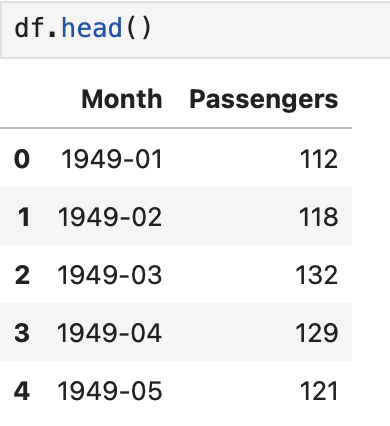Hello, Working with Pytorch since a few days, I still have difficulties with alignment of lstm output and linear layer input. Here the airflight passengers case and df.head() outlook.

Then coding:
lenght = len(timeseries)
ratio = 0.70
lenght_train = int(lenght * ratio)
train = timeseries[0:lenght_train]
test = timeseries[lenght_train:]
scaler = StandardScaler()
timeseries = scaler.fit_transform(timeseries)
train = scaler.fit_transform(train)
test = scaler.fit_transform(test)
seq_length = 4
def create_dataset(dataset, seq_length):
'transform timeseries into prediction dataset'
'arguments:'
'1. dataset: numpy array which first dimension is time step'
'2. lookbach: size of window to make predictions'
X= []
y = []
for i in range(len(dataset) - seq_length - 1):
feature = dataset[i: i + seq_length]
target = dataset[i + seq_length]
X.append(feature)
y.append(target)
#print(X)
#print(y)
print('len(X): {}'.format(len(X)))
print('len(y): {}'.format(len(y)))
X = np.asarray(X)
y = np.asarray(y)
print('X array.shape: {}'.format(X.shape))
print('y array.shape: {}'.format(y.shape))
return X, y
X_ts, y_ts = create_dataset(timeseries, seq_length)
print('X_ts.shape: {}, y_ts.shape: {}'.format(X_ts.shape, y_ts.shape))
len(X): 139
len(y): 139
X array.shape: (139, 4, 1)
y array.shape: (139, 1)
X_ts.shape: (139, 4, 1), y_ts.shape: (139, 1)
X_train, y_train = create_dataset(train, seq_length)
print('X_train.shape: {}, y_train.shape: {}'.format(X_train.shape, y_train.shape))
len(X): 95
len(y): 95
X array.shape: (95, 4, 1)
y array.shape: (95, 1)
X_train.shape: (95, 4, 1), y_train.shape: (95, 1)
X_test, y_test = create_dataset(test, seq_length)
X_ts = Variable(torch.Tensor(X_ts))
y_ts = Variable(torch.Tensor(y_ts))
X_train = Variable(torch.Tensor(X_train))
y_train = Variable(torch.Tensor(y_train))
X_test = Variable(torch.Tensor(X_test))
y_test = Variable(torch.Tensor(y_test))```
LSTM model looks the following:
```input_size = 1
hidden_size_1 = 128
hidden_size_2 = 64
n_epochs = 200
counter = 0
best_loss = 100
class lstm_airflight(nn.Module):
def __init__(self):
super().__init__()
self.lstm_1 = nn.LSTM(input_size=input_size, hidden_size=hidden_size_1, num_layers=1, batch_first=True)
self.dropout_1 = nn.Dropout(0.2)
self.lstm_2 = nn.LSTM(input_size=hidden_size_1, hidden_size=hidden_size_2, num_layers=1, batch_first=True)
self.flat = nn.Flatten()
# Linear layer expects dimensions to be batch, hidden_size
in_features = hidden_size_2
out_features = 32
self.linear_1 = nn.Linear(in_features=in_features, out_features=out_features)
self.dropout_2 = nn.Dropout(0.2)
self.relu_1 = nn.ReLU()
in_features = out_features
out_features = 16
self.linear_2 = nn.Linear(in_features=in_features, out_features=out_features)
self.dropout_3 = nn.Dropout(0.2)
self.relu_2 = nn.ReLU()
in_features = out_features
out_features = 1
self.linear_3 = nn.Linear(in_features=in_features, out_features=out_features)
def forward(self, x):
x, notused = self.lstm_1(x)
#print('lstm_1_output shape: {}, lstm_1_notused shape: {}'.format(x.shape, len(notused)))
x = self.dropout_1(x)
x, _ = self.lstm_2(x)
#print('lstm_2_output shape: {}, lstm_2_notused shape: {}'.format(x.shape, len(notused)))
x = self.flat(x)
x = self.linear_1(x)
#print('linear_1_output shape: {}'.format(x.shape))
x = self.dropout_2(x)
x = self.relu_1(x)
x = self.linear_2(x)
#print('linear_2_output shape: {}'.format(x.shape))
x = self.dropout_3(x)
x = self.relu_2(x)
#print('ReLU_2_output shape: {}'.format(x.shape))
x = self.linear_3(x)
#print('linear_2_output shape: {}'.format(x.shape))
return x```
```model = lstm_airflight()
print(model)```
Printing model output:
```lstm_airflight(
(lstm_1): LSTM(1, 128, batch_first=True)
(dropout_1): Dropout(p=0.2, inplace=False)
(lstm_2): LSTM(128, 64, batch_first=True)
(flat): Flatten(start_dim=1, end_dim=-1)
(linear_1): Linear(in_features=64, out_features=32, bias=True)
(dropout_2): Dropout(p=0.2, inplace=False)
(relu_1): ReLU()
(linear_2): Linear(in_features=32, out_features=16, bias=True)
(dropout_3): Dropout(p=0.2, inplace=False)
(relu_2): ReLU()
(linear_3): Linear(in_features=16, out_features=1, bias=True)
)```
Loss & optimizer:
```optimizer = Adam(model.parameters())
loss_fn = nn.MSELoss()```
Training:
```l_train = []
l_test = []
d_train = {}
d_test = {}
l_y_pred_tr = []
l_y_pred_t = []
#best_loss = 100
nb_loop = 0
path = '/Users/olivierdebeyssac/Python_LSTM/best_model.pt'
for epoch in range(n_epochs):
model.train()
for X, y in zip(X_train, y_train):
nb_loop = nb_loop + 1
y_pred = model(X)
if nb_loop < 2:
print('nb_loop: {}'.format(nb_loop))
print('===========')
print('nb_loop: {}'.format(nb_loop))
print('X.shape: {}'.format(X.shape))
print('y_pred.shape: {}, y: {}'.format(y_pred.shape, y.shape))
print('===========')
loss_train = loss_fn (y_pred, y)
l_train.append(loss_train.detach().numpy())
optimizer.zero_grad()
loss_train.backward()
optimizer.step()
d_train[epoch] = np.mean(l_train)
model.eval()
for X, y in zip(X_test, y_test):
with torch.no_grad():
y_pred = model(X)
loss_test = loss_fn(y_pred, y)
l_test.append(loss_test.numpy())
d_test[epoch] = np.mean(l_test)
Printing training output:
nb_loop: 1
nb_loop: 1
X.shape: torch.Size([4, 1])
y_pred.shape: torch.Size([4, 1]), y: torch.Size([1])
/Library/Frameworks/Python.framework/Versions/3.12/lib/python3.12/site-packages/torch/nn/modules/loss.py:535: UserWarning:
Using a target size (torch.Size([1])) that is different to the input size (torch.Size([4, 1])). This will likely lead to incorrect results due to broadcasting. Please ensure they have the same size.
I see that MSE loss function get y_pred which shape is [4, 1] and y shape [1], two dimensions tensor vs. one dimension tensor. So, y_pred is 4 values while y is only one.
I was expecting y_pred to be only one value (even in two dimensions).
How can I solve that problem ?
Many thanks for advise and help !
